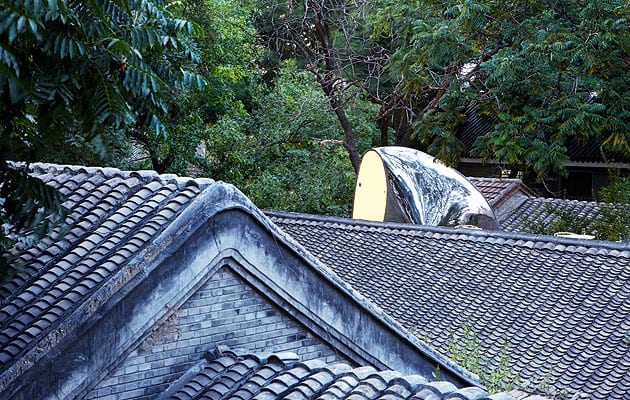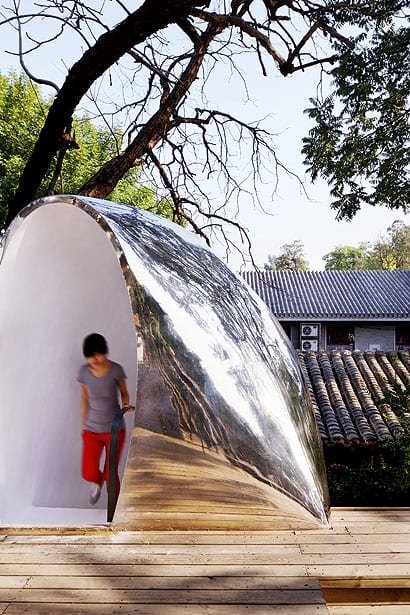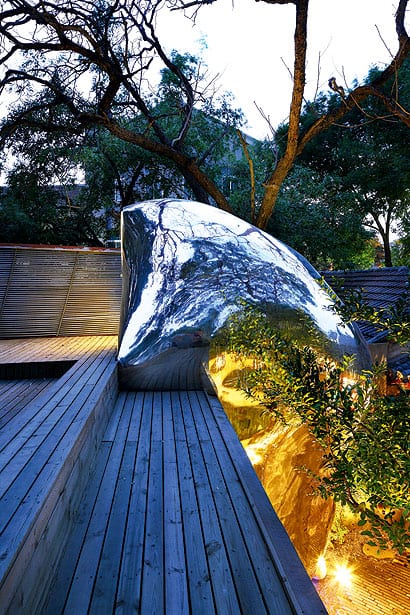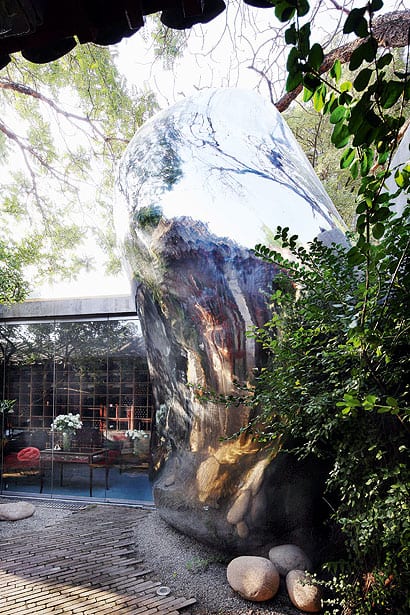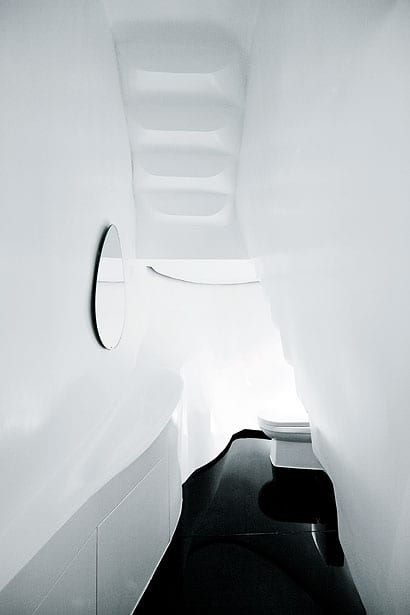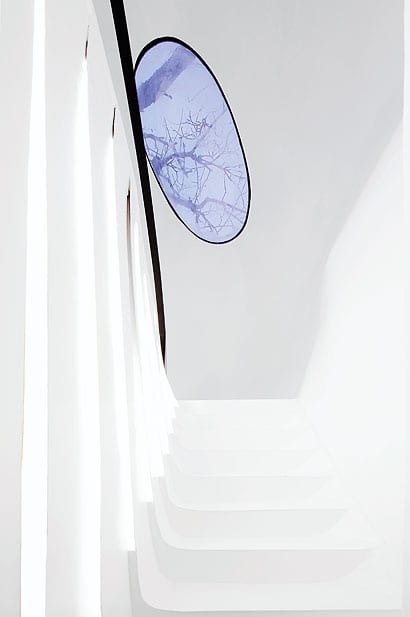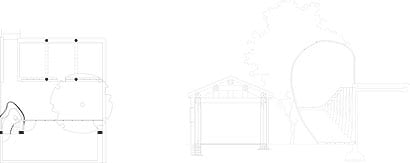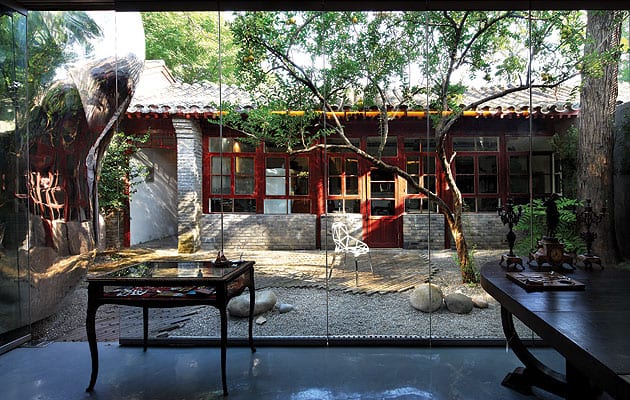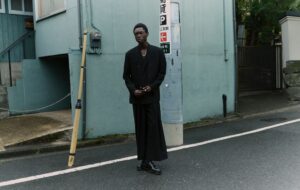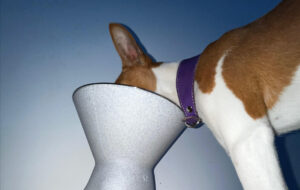|
Hutong Bubble 32 looms over the rooftops |
||
|
A strange new presence has popped up in the Nan Luo Gu Xiang section of Beijing. Its form is vague and its function is limited. It is modest in size, but nevertheless demands attention, first for itself and then for its neighbourhood, a patchwork of greyscale courtyard homes commonly known as a hutong. The form – a silvery, luminescent blob called Hutong Bubble 32 – is the work of MAD, the Beijing-based studio led by Ma Yansong, a 30-something architect raised in a hutong not far from Nan Luo Gu Xiang. Its creators describe the piece as a bubble, but that’s somewhat misleading. It doesn’t appear light or insubstantial; from outside it looks unbreakable, a shelter for something mysterious and precious. The truth is more simple: Bubble 32 is, in fact, a designer outhouse. Beneath its captivating shell are a single toilet and a staircase that connects a courtyard to a rooftop terrace. It is a small addition to a private home and its value is derived more from the presence it projects than the facilities it provides. Still, the presence is considerable. Bubble 32 is an alluring figure, a curious combination of substance and blur. It is unlike anything in the area and it seems somehow at odds even with itself. From the courtyard, it appears to be strenuously hoisting its frame onto the roof; from the roof it appears to be at the tail end of a collapse. Although its rounded shape compliments its neighbours’ sloped roofs, the Hutong Bubble 32 is a form so alien that one can’t help but imagine other environments in which it might be more at home – in a forest, for instance (from certain angles it looks like a giant slug), or possibly in the sea (from others it resembles a glitzy periscope). Its exterior is coated in stainless steel, highly polished and reflective. Like a funhouse mirror, it deforms everything around it, remaking its straight-angled environment in its own bulbous image. Elements that are independent in the material world melt into each other on the Bubble’s facade, which creates an ever-changing, semi-psychedelic universe parallel to the staid courtyard that surrounds it. The architect describes this in poetic terms: “The surface reflects the mixture of old buildings, the courtyard, trees and sky,” Ma Yansong explains. “The reflection is like an image in a dream.” Like a dream, Ma’s Bubble is a collection of intuitive, sometimes contradictory, elements. Its form is at once mercurial and glacial, exhibitionist and shy. The building lurches and squirms; it demands attention, but reveals nothing. Once you enter, a new set of contradictions await. The interior is gentle in structure and harsh in colour. There are no straight angles; the walls are blubbery, the window is oval, even the stairs are rounded off. The effects are clearly computer-generated but their effect is somehow naturalistic; strong but soft, snug perhaps like the inside of a peapod. But the colouring counteracts this quality – the floor is shiny black and everything else is alabaster. The combination gives the space a distinctly inorganic, laboratorial feel. It doesn’t take much time inside to figure out where this quality comes from; the Bubble is, ultimately, a highly stylised lavatory and its throne sits proudly in the back, bathed in light, radiating an antiseptic aura that contaminates the rest of the space. In describing Bubble 32, Ma seems less concerned with his own glimmering creation than the muted buildings that surround it. The project is in large part a response to the architect’s own melancholy assessment of Beijing’s courtyards, and it would be unfair to consider his Bubble without positioning it within the fragile context that its presence animates and disrupts. “In the courtyards that have survived there are two situations,” Ma explains. “It either looks exactly like it did 30 years ago – no gas, no heating, no toilet – or it has become a huge, newly renovated traditional-looking concrete villa for rich people.” A brief walk in the neighbourhood surrounding Bubble 32 reveals what he means. It is an odd environment, a mixture of pushy SUVs, scrawny cats, tour groups, hanging underwear and putrid toilets. “My worry is,” he continues, “that if the people who have lived there forever have to leave, and the area becomes a villa district for the few, then the community will disappear. The ‘urban fabric’ might be preserved, but it is meaningless without human life in it.” The decline of Beijing’s hutongs presents complex problems for which a fancy staircase is not a solution. Ma is quick to point out that the significance of Bubble 32 is primarily symbolic. It points to what could be done, and how a few well-planned, well-placed interventions could modernise a decaying neighbourhood, adding needed facilities and drawing attention to a disappearing urban culture. “For me, it doesn’t really matter what the shape is,” he says. “What’s important is having a new element to regenerate the old and poor houses.” The fact that this charitable ambition starts in the courtyard of one of the neighbourhood’s new, rich residents is an irony not lost on the architect. “It obviously cannot only be an architect’s dream,” he explains. “It needs support. It is also related to government policy, social issues and financial issues. But I always believe that an open discussion and an experiment can bring positive opportunity.” It’s too soon to tell whether MAD’s tiny addition marks the start of something big. For his part, Ma is optimistic, making reference to Beijing 2050, the visionary exhibition in which MAD first introduced the Hutong Bubble concept. The architect concludes: “Now I think we might be able to do it before 2050.”
A staircase connects the courtyard to a roof terrace
The polished stainless-steel surface animates its environment
The bulbous form of Hutong Bubble 32 is clearly computer-generated, but also naturalistic
The antiseptic white toilet
A psychedelic window floats into view
|
Image Shu He
Words Brendan McGetrick |
|
|
||
|
The traditional hutong courtyard, Bubble at left |
||

